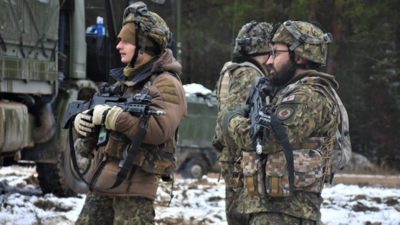Despite Afghan fiasco, US puts boots on ground again in foreign lands


The US plans to deploy troops to fortify NATO forces in eastern Europe amid fears that Russia could invade Ukraine, a senior official of President Joe Biden’s administration said (AFP)
WASHINGTON: American troops are heading out for foreign shores yet again, only months after a humiliating withdrawing from Afghanistan in a fiasco that shook Washington. US President Joe Biden on Wednesday approved deployment of about 3,000 additional American troops to Eastern Europe amid ceaseless wrangling with Russia over Ukraine, on whose borders Pentagon says Moscow has amassed 100,000 troops ready to invade the former Soviet territory.
US officials emphasized that American troops are not being deployed in Ukraine but instead will go to Poland and Romania to protect NATO’s eastern flank. Roughly 1000 personnel based in Germany will move to Romania, and another 2000 will depart shortly from Fort Bragg military base in North Carolina. Of these 1700 members from 82nd Airborne Division will go to Poland and 300 members from 18th Airborne Corps will go to Germany.
The officials maintained that the moves are not permanent, defensive in nature, and that Washington is only responding to “current conditions,” while aiming to reassure NATO allies and meet US commitments to protect them. However, Pentagon spokesperson John Kirby said the newly deployed troops are going under bilateral arrangement with Germany, Poland, and Romania, and they will remain under US control.
“I want to be very clear about something: these are not permanent moves… Moreover, these forces are not going to fight in Ukraine. They are going to ensure the robust defense of our NATO allies,” Kirby said.
At a broader policy level, there is apprehension in the Biden administration that if the US does not show up in military terms, it will further embolden Russia to train its sights on other former Soviet Republics to try and reconstitute USSR 2.0, which American analysts see as Moscow’s endgame. Smaller NATO deployments are also expected in Baltic Republics that were part of the former Soviet Republic and which expect Moscow to turn the heat on them after Ukraine.
The US deployment came on the heels of sharp exchanges from both sides about who is the aggressor in Eastern Europe, the ideological battleground during the Cold War.
Responding to Moscow’s allegation that the US is being provocative by trying to rope in Ukraine into NATO, White House spokesperson Jen Psaki took to metaphors to rebut the charge, while alleging it is Russian President Vladimir Putin who has “invaded multiple countries in the past several years.”
“When the fox is screaming from the top of the henhouse that he’s scared of the chickens, which is essentially what they’re doing, that fear isn’t reported as a statement of fact. We know who the fox is in this case,” Psaki said.
Russia’s ambassador to US Anatoly Antonov retorted that it is the US interventions that brought the world “nothing but chaos, instability and loss of lives,” while excoriating Washington’s “bloody experiments” to bring democracy to the former Yugoslavia, Iraq, Syria and Afghanistan.
In Moscow, Kremlin spokesperson Dmitri Pescov wheeled out counter- metaphors, likening Russia not to a fox but to a bear- “an animal that, even if it wanted to, could not get on the roof of a chicken coop. It is too big and strong to do that.”
More metaphors besides rhetoric are in the offing with the bear heading out to meet panda over the weekend. Amid growing wariness and apprehension in Washington about a Russia-China alliance, President Putin is scheduled to attend the opening of the winter olympics in Beijing on Friday, with a bilateral meeting with President Xi on the margins.
FacebookTwitterLinkedinEMail
